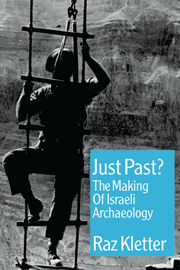Book contents
- Frontmatter
- Dedication
- Contents
- List of illustrations
- Introduction
- Acknowledgements
- Abbreviations
- 1 Archaeology and the 1948 War
- 2 Abandoned places, new places
- 3 Foreign aid
- 4 Frozen funds
- 5 A battalion of guards
- 6 Relief work
- 7 Man robs his land: “agreement” with General Dayan
- 8 “Gold of Ophir for Beth-Horon”: 3,000 shekels
- 9 The building beyond the border: the PAM, 1948–67
- 10 A building of dreams: a home for the IDAM and the origins of the Israel Museum, Jerusalem
- 11 A dead man on the council: the story of the supreme archaeological body in Israel
- 12 “But trust comes from the heart”: travels with the Government Tourist Corporation
- 13 “Whether in a courtyard of a synagogue, in a courtyard adjacent to a synagogue, or under a synagogue”: the Safad affair
- 14 The policy of salvage and early Israeli excavations
- 15 Myths and conclusions
- Appendix: other documents from the IDAM files
- Bibliography
- Author index
- Index
6 - Relief work
- Frontmatter
- Dedication
- Contents
- List of illustrations
- Introduction
- Acknowledgements
- Abbreviations
- 1 Archaeology and the 1948 War
- 2 Abandoned places, new places
- 3 Foreign aid
- 4 Frozen funds
- 5 A battalion of guards
- 6 Relief work
- 7 Man robs his land: “agreement” with General Dayan
- 8 “Gold of Ophir for Beth-Horon”: 3,000 shekels
- 9 The building beyond the border: the PAM, 1948–67
- 10 A building of dreams: a home for the IDAM and the origins of the Israel Museum, Jerusalem
- 11 A dead man on the council: the story of the supreme archaeological body in Israel
- 12 “But trust comes from the heart”: travels with the Government Tourist Corporation
- 13 “Whether in a courtyard of a synagogue, in a courtyard adjacent to a synagogue, or under a synagogue”: the Safad affair
- 14 The policy of salvage and early Israeli excavations
- 15 Myths and conclusions
- Appendix: other documents from the IDAM files
- Bibliography
- Author index
- Index
Summary
And whatever I do
Will become forever what I've done
Szymborska (1997: 170)INTRODUCTION
In the New York of the 1930s the economy was crushed and salaries for those who still had them were at rock bottom. Fifteen million Americans were unemployed. The federal government, facing tremendous difficulties, issued a policy of relief works. Roosevelt's ideology was that earning a living is a basic human dignity, preferable to handing out money and letting people sit idle. The first Relief Act was passed on 31 March 1933, and six weeks later a Federal Emergency Relief Administration was established. The emphasis at this stage was on supplying work immediately, so in November 1933 Congress established the Civil Works Administration, which created 4.2 million jobs in the space of just nine weeks. The jobs included laying sewer pipes and building and improving roads, playgrounds, schools and so on. By 1935 the government had put more stress on social and human values, with priority on fitting jobs to the skills and trades of the workers.
In April 1935 Congress approved a budget of $4.8 billion for the Emergency Relief Act. From this enormous sum some 5 percent – $27 million – was set aside for arts projects. A project called the Federal Theater received about $6.8 million for providing work to unemployed theatrical professionals, through “production units”: theatres. As a rule, each production unit could choose up to 10 percent of its workforce from professional actors, to ensure good standards of performance.
- Type
- Chapter
- Information
- Just Past?The Making of Israeli Archaeology, pp. 133 - 149Publisher: Acumen PublishingPrint publication year: 2006



